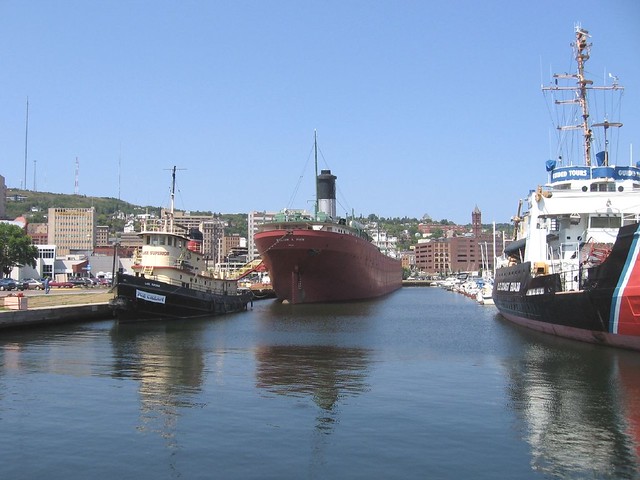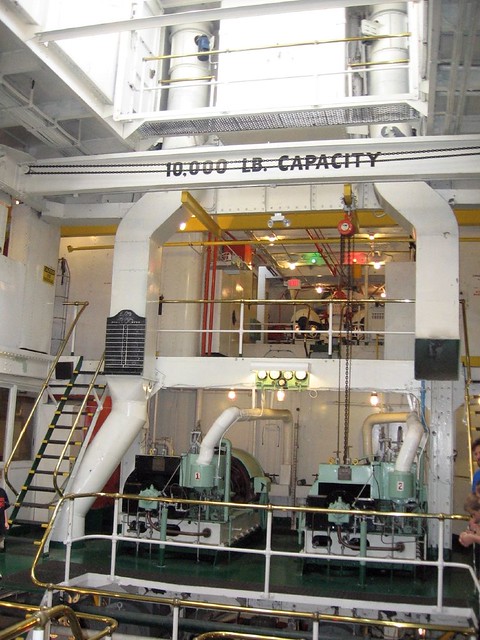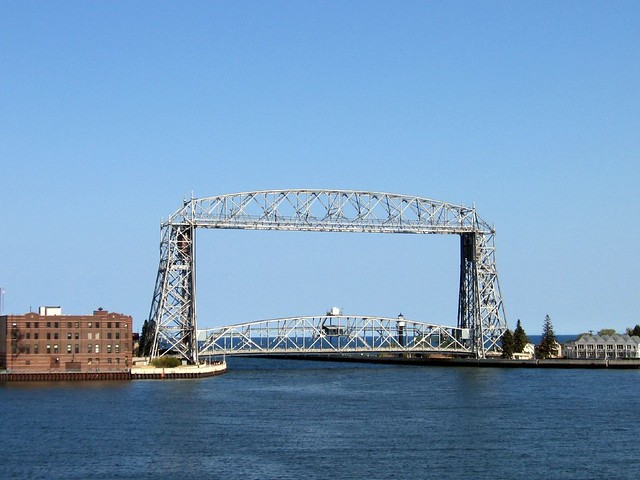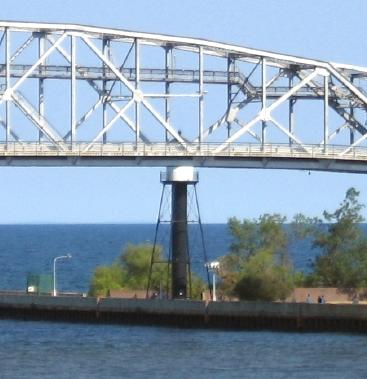Duluth, Minnesota (August 2007)

Our journey through the upper Midwest brought us as far north as Duluth. Here a city rises along the westernmost deep-water port with access to the Atlantic Ocean. This is all the more surprising because it’s a good third of the way across the continent. Even so, ships — massively large ships — set sail from Duluth and can travel more than 2,300 miles all the way through Lake Superior and the other Great Lakes, to the St. Lawrence Seaway and finally reach the ocean.
In recent years Duluth has embraced its maritime heritage as a way to attract visitors and help the local economy. Canal park was once a home to freighters, longshoremen, and warehouses. It’s fortunes began to decline in the second half of the twentieth century as it transformed into an unattractive industrial waterfront cut off from the rest of the city by several lanes of busy interstate highway. Today, however, it has been converted into a vibrant destination for locals and tourists alike with shops, restaurants, museums, an aquarium and convention center (map). It reminded me of a small-scale version of Baltimore’s famous Inner Harbor which similarly serves as an anchor for economic development.
The Ships
Canal Park hugs the northwest extremity of Superior Bay, backing up to downtown Duluth and the surprisingly steep hills that rise beyond the shoreline. Tucked at the rear of the park is a finger of water that rests between Harbor Drive and Lake Avenue. Here can be found the Great Lakes Floating Maritime Museum. The ship on the left of this photograph is the U.S. Army Corps of Engineers tugboat Lake Superior, now oddly enough with an ice cream stand built into it. Visitors can walk up to the ship and order a sugar cone and stroll around the park with a refreshing snack on a hot summer day.
The ship on the right is the U.S. Coast Guard Cutter Sundew (WLB-404). This 180 foot seagoing buoy tender, built right in Duluth in 1944, served faithfully in the Great Lakes for sixty years before decommissioning in 2004. Now it is owned by the City of Duluth and is open to visitors as one of the major exhibits in the floating museum. The large ship in the middle with its rust-colored red paint is the lovingly maintained bulk carrier S.S. William A. Irvin. It was once part of the Pittsburgh Steamship Division of US Steel, receiving its name from the company’s fourth president. She served as their flagship from the time of her launch in 1938 through 1975, and was retired in 1978, for an amazing run of forty years.
S.S. William A. Irvin

The William A. Irvin presents an even more impressive scale when viewed from its superstructure. Looking along the entirety of its 610 feet and off to the horizon, we spied Superior Bay straight ahead along with its famous aerial lift bridge. Guided tours show visitors every corner of the ship. We walked the entire length of the loading deck and learned where machinery slid large hatches aside to pour mountains of coal or iron ore into colossal bins below. We saw narrow passageways just below the deck that ran the length of the ship so that sailors could safely traverse the vessel during bad weather without fear of being washed overboard.
Then we toured through richly appointed luxury suites trimmed with oak paneling and brass fixtures that befit an important corporate flagship, the well-appointed accommodations for visiting dignitaries. We finished by shuffling through echoing cargo holds that were so large that they could engulf a row of townhouses with room to spare if anyone had been so inclined. Instead it once provided space for 13,600 gross tons of bulk cargo. We found it amazing that one of the reasons they retired the ship was that newer vessels are considerably larger.
Engine Room

The William A. Irvin contained an equally cavernous engine room. It was one of the first ships to be powered by a Delaval Cross steam turbines that created 2,000 horsepower and propelled the ship at 11 miles per hour with a full load. It took more than a ton of coal each hour to generate enough steam to keep the ship underway.
The engine room itself was several stories high. It contained both a Chadburn telegraph and a sound-powered phone that allowed communication with other parts of the ship. The captain in the pilothouse used the telegraph to signal engineers in the engine room to set the proper propeller speeds. The sound-powered phones could be used as a backup system in the event of electrical disruption or failure.
An Iconic Bridge

The other end of Canal Park contains a truly iconic emblem of Duluth, the renowned Aerial Lift Bridge. It spans 390 feet across a man-made shortcut through Minnesota Point. The canal provides ships with direct access to Lake Superior and allows them to avoid a seven mile jaunt up the St. Louis river to its natural mouth.
The bridge has an interesting history. It was built originally in 1905 as an extremely rare type of span called a transporter bridge. Only one other such bridge was ever built in the United States. People who wished to cross the canal got into what might be characterized as a giant basket that lifted upward on a pulley, then slid horizontally across the span, and was finally lowered to the ground at the other end. It sounds more like a carnival ride and a pretty inconvenient one at that.
Aerial Lift
Apparently the city fathers also thought it was odd because in 1929 they redeployed it as an aerial lift or vertical lift bridge. That too is an unusual design but not nearly as strange as what it replaced. People have continuous access back-and-forth across the bridge until a ship approaches. Then the entire bridge deck lifts vertically into the air and allows a vessel to proceed directly beneath it. We watched this process in operation several times while perched on the second floor balcony of the Great Lakes Aquarium where this photograph was taken. Every time the process repeated I had to smile.
Duluth Rear Range Light

As the bridge lifts, the Duluth Rear Range Light comes into better view. There isn’t much room for ships to maneuver as they approach the short, narrow canal. A series of lighthouses at the cut allows vessels to line up on the lights to traverse the cut straight-on.
One of those, the Rear Range light, consists of an iron cylinder eight feet in diameter encasing a spiral staircase (map). Atop the cylinder rests a small circular room that once held a fourth order Fresnel lens but which has since been replaced by an acrylic optic with a focal plane of 68 feet. A nearby museum now houses the original lens. In the distance we could see the vast blue expanse of Lake Superior extending to the farthest reaches of the visual horizon.
Readers who have an interest in lighthouses might also want to check my Lighthouse Index page.

Leave a Reply